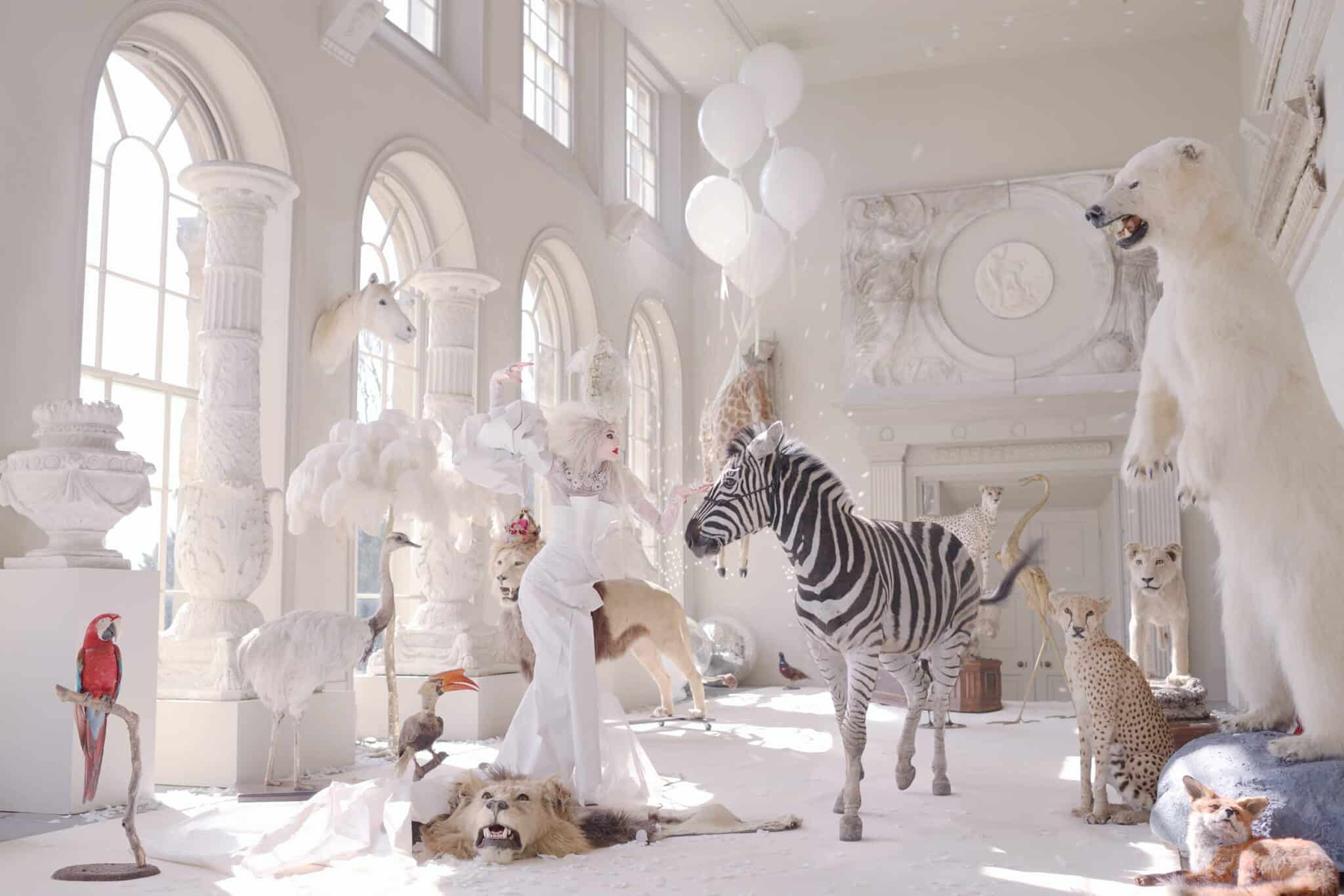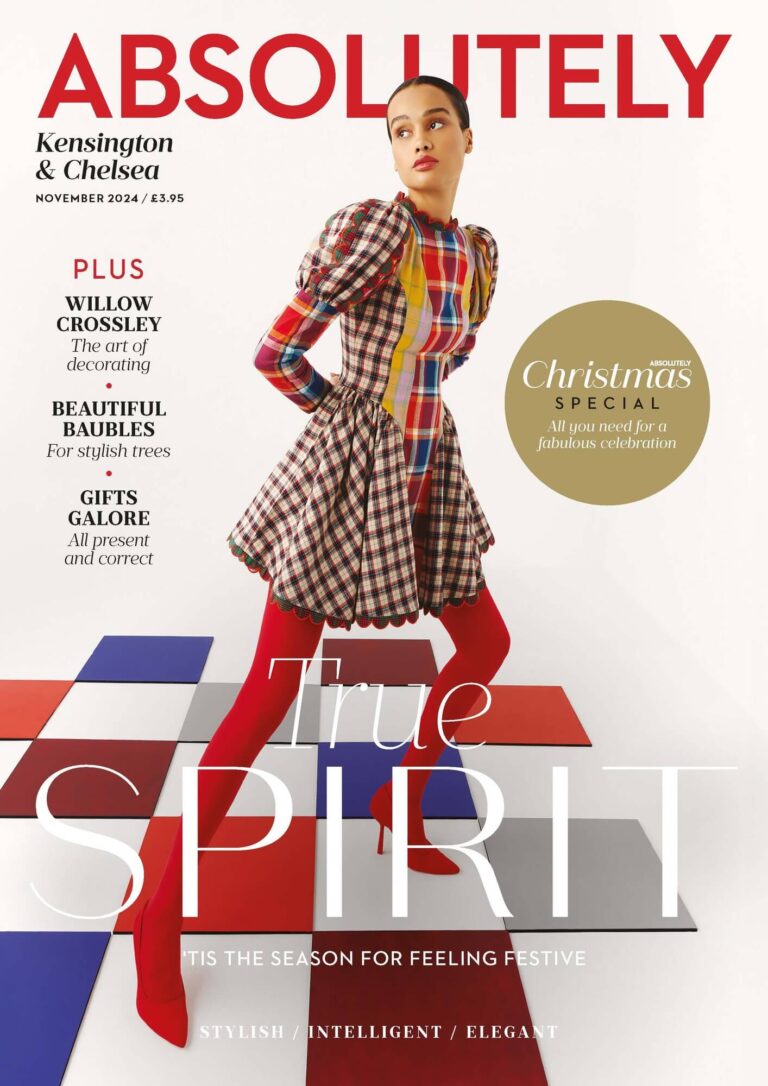Since launching Surreal Fashion in 2011, Natalie Lennard has been one of the hottest names in photography. The Brighton local lets us into her life to discuss fusing fashion and history, and why her latest series is a scream
Where did your love for photography first stem from?
I have always been creative and photography became my main way to manifest visual desires when I was a teenager making self-portraits. I loved the immediacy, privacy and post-production possibilities of digital photography.
When studying, did you have an ambition to do something different?
I kept my options open right through to university level by choosing to study English, especially as the main other career interest I had was being a journalist. It was whilst studying English that I got into photography in my spare time.
When did you first explore combining contemporary fashion with classical art history?
Surreal Fashion began in 2011 when I created an image called ‘Storm Door’ at Weston Park in the UK. Inspired by the paintings on the wall, I photographed one painting of ships and found myself fusing it into a portrait of a fashion model.
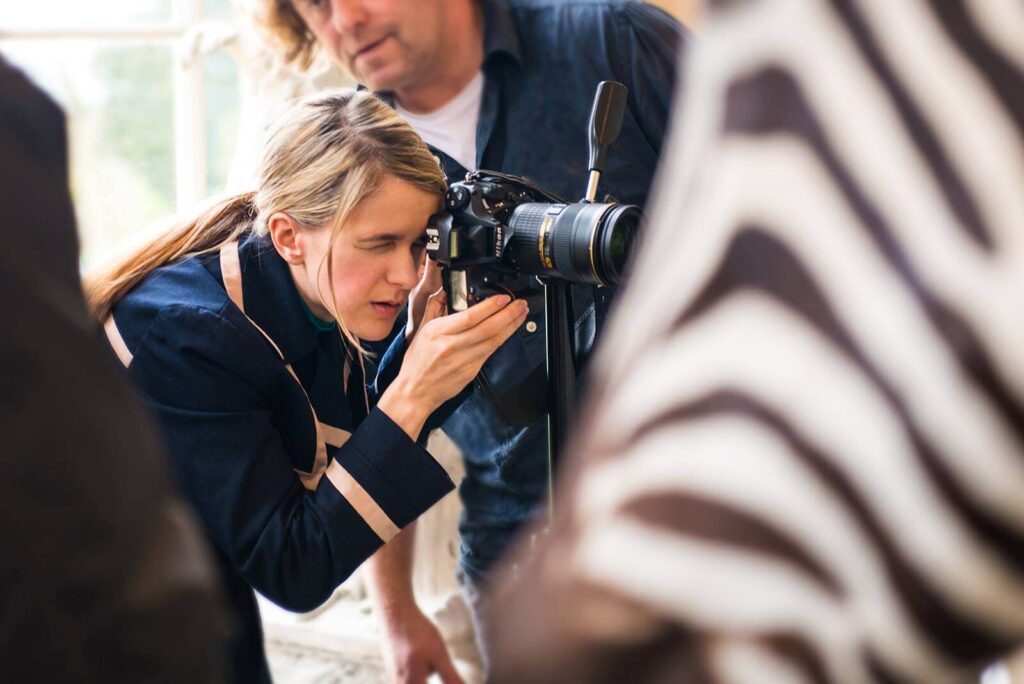
Why did this fusion appeal to you?
I, at first unconsciously, had a desire to make something more than fashion, something that would stand out and hark back to the ages of laborious craft in art history. It is a way of celebrating my love for costume and history, and for stately houses through England, Europe and the US, that I use to stage the photos.
I have always been inspired by femininity, colour, boldness, surrealism. Surreal Fashion is a celebration of opulence, theatricality and prestigious locations; a party of colour, beauty and escapism. And in my Faces Series, such as Kai Face, I wanted to concentrate the beauty and intricacy of art history into one canvas of a face, for a large-scale piece that the viewer could lose themselves in exploring every detail.
I am about crafting something laboriously beautiful. I most enjoy paintings of the past, for its intricate and skilled craft that brings history and concept to life, in a way that modern art doesn’t do as much. I love to see art that has taken time and consideration, not just some quick easy technique to piggyback off trends and hype in the art world.
What were your early creations?
I found myself discovering photography in my spare time as a student in my teenage years then again at university in 2006. I first started out by photographing myself in self-portraiture, which I came to call ‘Self-Gazing’. I became hooked by the immediacy of the digital photographic medium and the luxuriously private process that could involve no-one but myself, like a painter working with pixels. I used myself as a model for seven years before I moved onto other models.
Early on, it seemed that fashion could be the most obvious route for my aesthetic, but it took me only a short time to realise I was more interested in fashion as art, beyond the disposable pages of a magazine, but standalone works that could be timelessly hung and enjoyed. It was a challenge to find stylists, makeup and hair artists that can help rather than hinder this process of creating fine art rather than fashion, and I am fortunate now to have solid, talented team members who have stood the test of time.
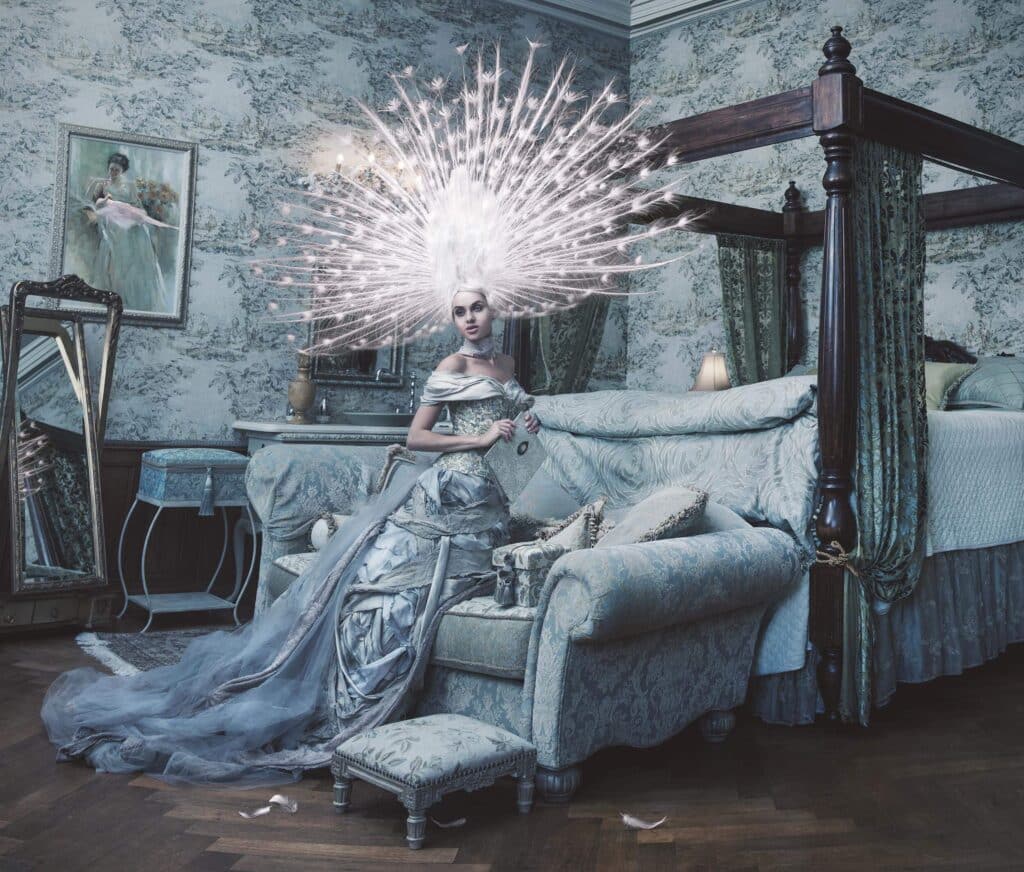
I can’t get enough of the Surreal Fashion series of works. What did you want to create with this body of work?
I want to create bold unforgettable images. I like to think my work goes beyond photography into the realm of painting, to evoke a feeling of nostalgia and cinematic flair. I want to create standalone works that stand the test of time as art pieces, that are inspired yet original, beautiful visual experiences.
How did you go about creating the shots?
In my earliest self-portraits I used only natural light, whereas from Surreal Fashion onwards I always use lights, and may often use high-speed-sync strobes to almost cut out natural light completely and carve the light from scratch. It is not easy to make a photo look like a painting – I am often asked how to do it and I am never quite sure how to answer. It is a mix of the lighting technique, the location and posing, and the subtle colour enhancements in editing.
Some images are shot all in-camera, using for example the taxidermy collection of Aynhoe Park and the 500-year-old golden gilt of the Elizabeth Room in Belvoir Castle. Sometimes I will directly insert pieces of classical art, or a stock photo from nature. For example, one image of a model is fused with the sea of the Big Sur to create an almost sculptural surrealism of the model’s dress turning into waves of the ocean. Whilst most images take only a couple days’ post-production, images in my Faces Series took months collaging a face with hundreds of paintings, to make a digital tapestry that blends ancient and contemporary in intricate detail specially for large-scale viewing. I want my viewers to be able to lose themselves in the detail of my work.
If possible, can you pick your 3 favourite pieces from the series and explain why you love them?
I love Pokerface, because it was shot all in-camera with huge playing cards (all sellotaped together and knocked over by a ghost on the day), and I like the nonchalant and wistful, almost effortless appearance of the model. Swan Lake, because by contrast, it has a great deal of processing to achieve the surreal illusion of the sea, and I think it worked well. And a third would be Enter the Golden Dragon, for being a party of decadent golds, combining a model shot in Beijing, with a sumptuous setting in Gdansk.

What inspired the Birth Undisturbed series?
In Birth Undisturbed I have explored a deeper topic in my work beyond simply superficial glamorous images as in Surreal Fashion, but for me, substance never comes as a substitute for style. I still want to serve a highly aesthetic and visually exciting vision.
Around 2017 I became fed up of only shooting pretty pouting models. I’d given birth and experienced the most amazing thing a female body could do, and I wanted my work to be able to say something – or rather, scream something. I felt called to bring birth into art, and throw a pot of maternal gorgeousness into a culture that sidelines birth as a mere footnote. Could I place birth into the genre of narrative photography, where we normally see plenty of beautifully deadpan characters hanging around, doing nothing? Could I make beautiful art out of the ‘disgusting miracle of nature’? Make it look powerful, even exciting, place it in different locations than just the hospital setting we see on TV and in movies? Inspiration has come from my own motherhood and I wanted to share what I’d learned about birth through my art in some way.
How would you describe the work?
I would describe it as an original series that presents birth narratives in a way we’re not used to seeing, with interesting historical stories along the way. Three iconic figures: the Virgin Mary, Calamity Jane and Queen Elizabeth II, become powerful opportunities to picture birth in a way we have never seen, or dared ask for. In ‘The Creation of Man’ we experience the primal power of a birthing Virgin Mary in the physical act of crowning Christ, whilst in ‘Royal Blood’ we witness the homebirth of Queen Elizabeth II in 1964 to Prince Edward, which broke four traditions in Royal history. In ‘Born of Calamity’ we see birth in a chaotic Wild West town – but within its traditional female space, set against the outer gun-touting masculine world.
I have drawn on influential birth writers, and visualised ideas from famous birth literature. I stage a pre-Raphaelite redhead woman birthing on a doorstep by a 50s Chevrolet in ‘Ejection Reflex’ to refer to the term ‘fetal ejection reflex’ coined by Niles Newton. In ‘Salle Sauvage’ I shot a screaming model inside a glass Cube in London to create a metaphor for French birth writer Michel Odent’s term that means ‘primitive room’. In ‘The Whitechapel Woman’, I bring to life a famous London 1911 scene of Dr. Grantly Dick-Read, the English doctor who discovered hormones and founded the NCT (National Childbirth Trust).
Religion, as well as biology, has an important place in the series. ‘Aquadural’ harks back to 2700BC to depict the ancient roots of waterbirth. ‘Call to Prayer’ brings us to a modern-day Muslim family birthing in a hospital, where the father whispers into the ear of the newborn. In ‘Power Pilgrimage’ the father is canoodling with this wife, spliff in her hand as she serenely crowns her baby onto a bus bunk – depicting the first birth in 1971 that inspired the hippie ‘mother of midwifery’, Ina May Gaskin.
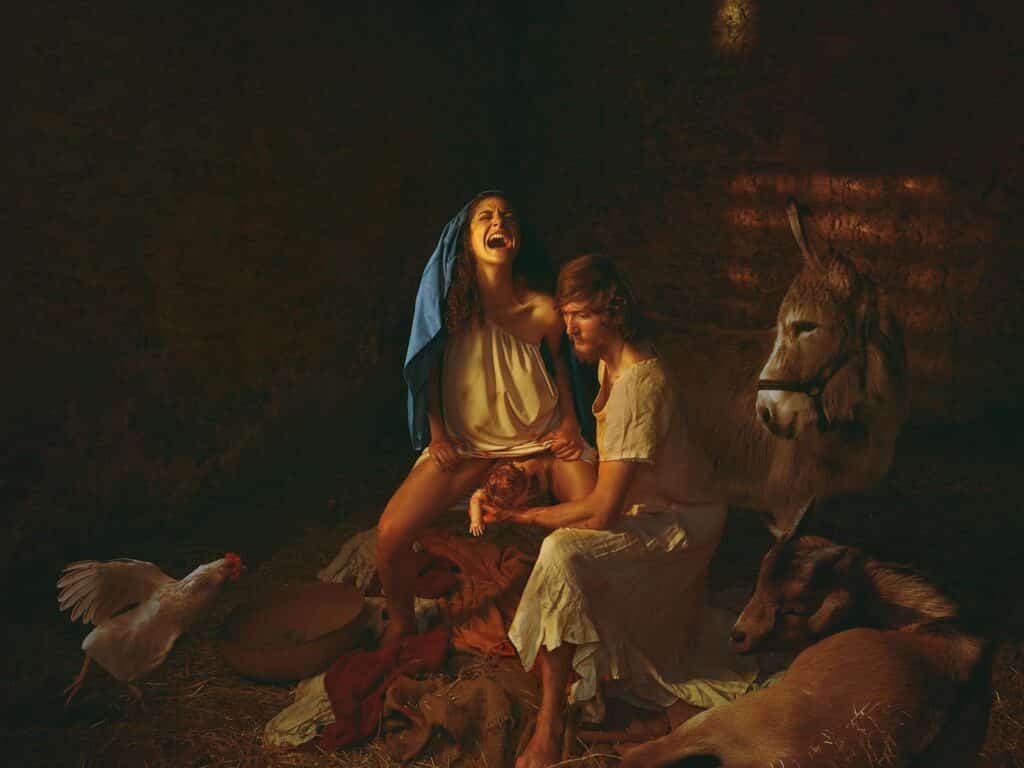
How has it evolved?
When I first started out, I thought the whole series would be about homebirth, but it became a lot more historically and culturally diverse. I didn’t expect the response I got to ‘The Creation of Man’ (the birthing Virgin Mary), which has been hands-down the most well-received image of the whole series, the most talked-about, and most sold as a print. I’ve had a massive positive reaction even from Christian mothers who have ‘waited all their lives for this picture’. In the most flattering moment probably of my entire career, a man paid me for this print in advance when he learned I was taking on the Nativity – before I even made it.
Each image comes accompanied with a short film, and these began just as ‘behind the scenes’ to help show the detail of the massive hundred-megapixel photos, but I came to find increasing joy in the creative side of filmmaking as I went on. ‘Call to Prayer’, the eighth in the series, was featured at Aesthetics Short Film Festival.
When I began the series, I was keen for birth to be seen in a certain ‘powerful, natural’ way, and I crammed my videos with rather didactic speech. Five years later, I think the stories alone speak for themselves without the need for it. I’m happy for viewers to think what they want, after all, art is a litmus test that exposes to you your own feelings.
Will it be completed this year?
Yes, I have just completed the series with the tenth chapter based on Adam and Eve. It has not yet been released, but I aim to unveil it this June.
How does your photography career fit in with your home life?
When we had our first daughter we continued doing plenty of photoshoots; after our second daughter, we wound down and focused on finishing and marketing all the material we’d shot. So it works well that I have lots of time at home to attend to two wild growing daughters, and our photoshoots are few and far between – long-planned and considered with plenty prep time to produce.
I believe you live just outside of Brighton. What do you love about the area?
Over the years we’ve lived in London, Kent and Exeter, and returned to the best place to be – Sussex. We love the proximity to city, sea, ports, airports and London, and of course the sheer national uniqueness of Brighton. The best of all worlds here!
Another top 3 question: where are your 3 favourite places to visit in the area?
Seaford Head for a walk with beautiful views.
Moksha cafe in Brighton for having the perfect balance of quality produce but also kid-friendly homeliness – not easy to find!
Arundel Castle – we’re always there to watch the summer jousting…
What’s next for you?
Child Undisturbed is a new body of work that continues on from Birth Undisturbed – moving onto childhood and similarly the idea of how we avoid ‘disturbing’ the growing of a person. The first piece ‘The Free Child’ is based on A.S Neill, a headmaster of the controversial school Summerhill, where I recreate a scene from his book where a 14-year-old boy smokes a cigarette with the headmaster in his 1960s office.
It might sound funny to say that now I’ve done birth, next comes sex and death. But I’d only be half joking. The next in the series I plan to be based on trauma, specifically the loss of a parent, and it brings with it a gamut of contentious imagery that I am aching to create. I guess you’ll have to watch this space!
Buy work through Zeno Fine Art https://www.zenofineart.com/collections/miss-aniela
Websites
Social media

